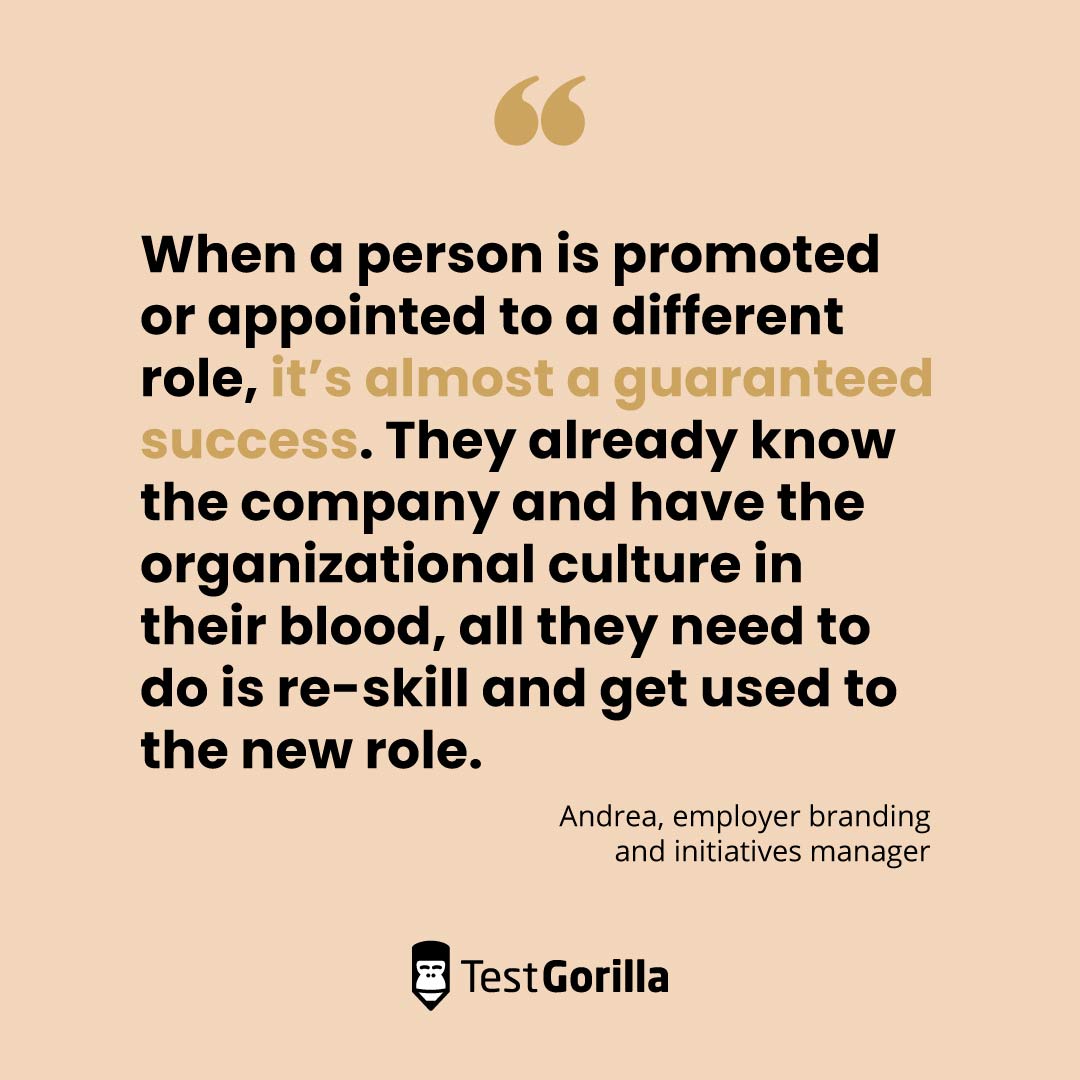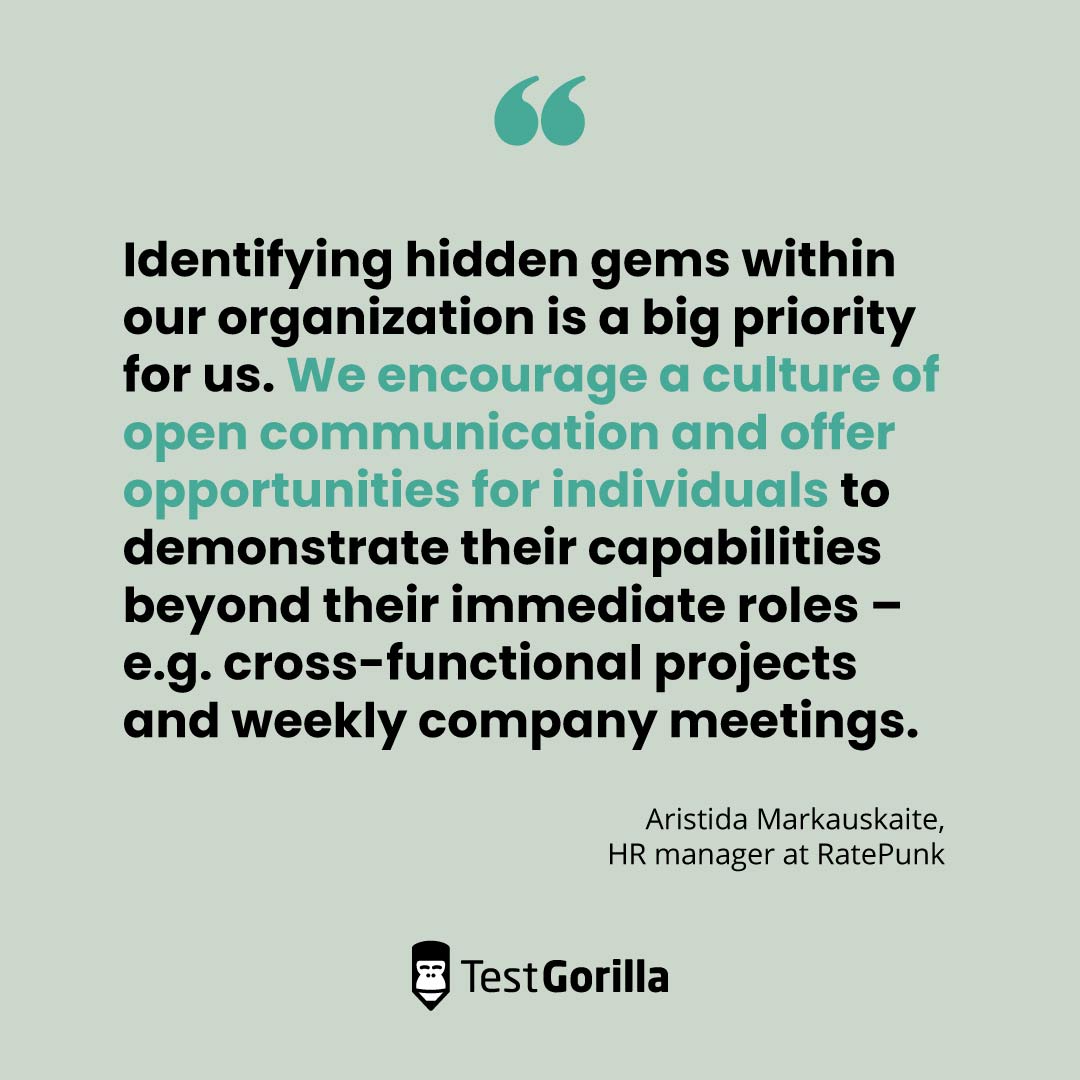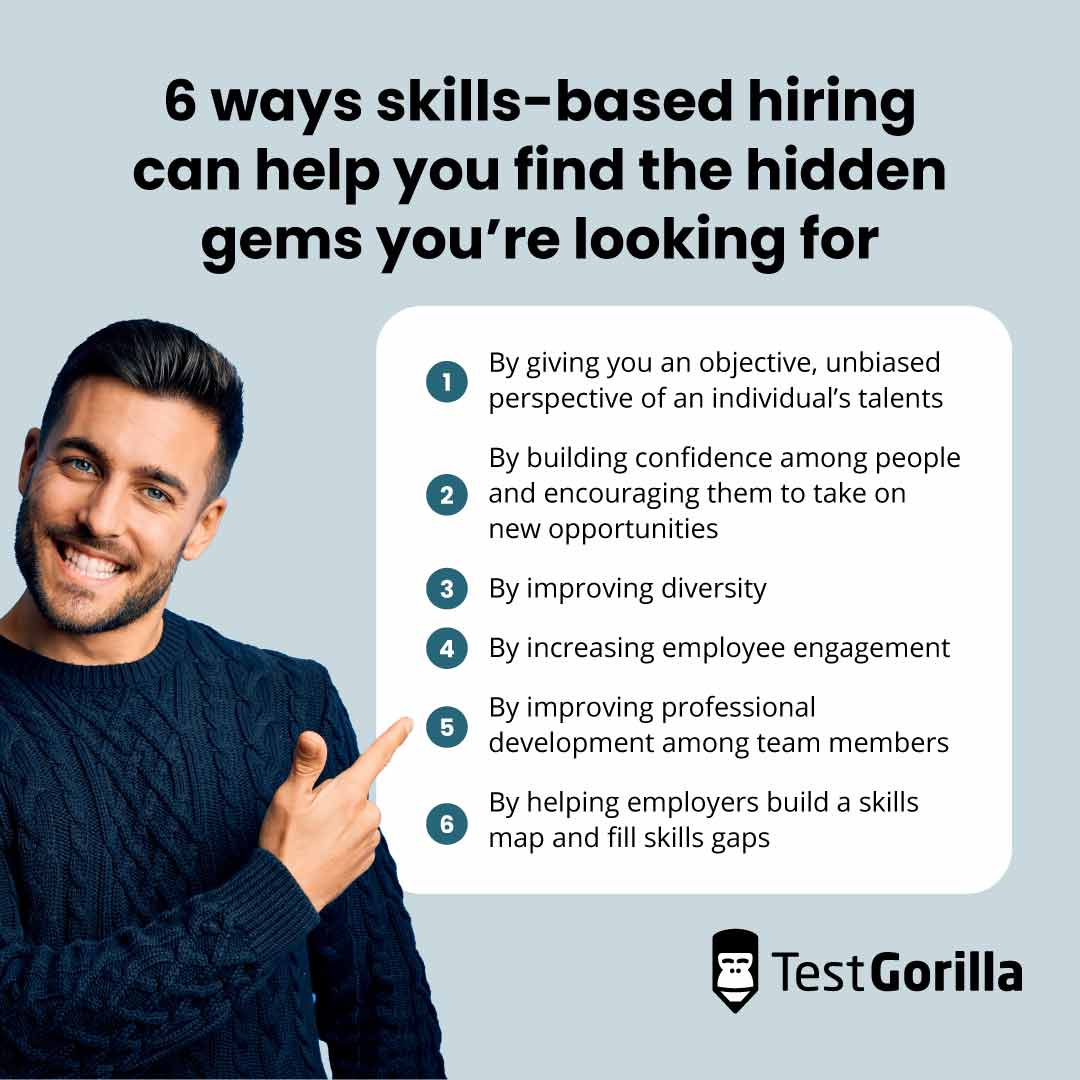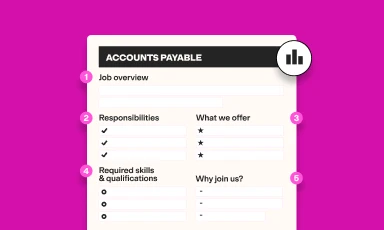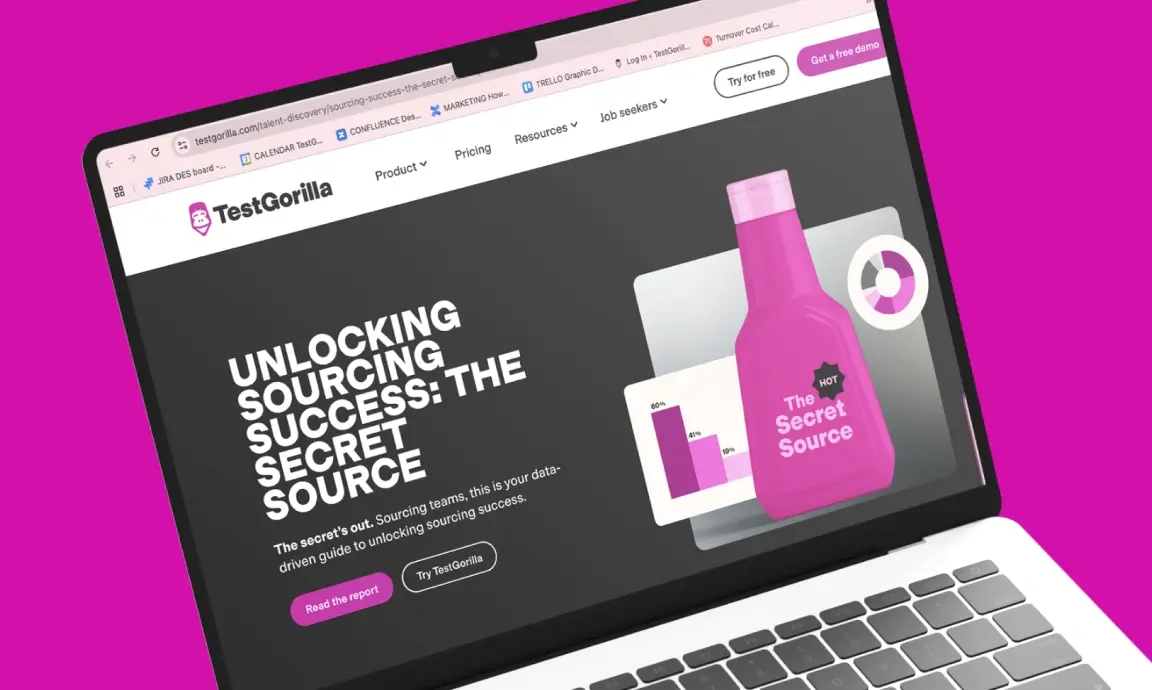6 ways skills-based hiring can help you identify hidden gems in your organization
The most skilled and capable individuals aren’t always the people you’d expect, or the loudest people in the room. As a result, in the quest to build high-performing teams, you might often overlook the hidden talent within your existing workforce. This is particularly the case for STARs (people skilled through alternative routes), individuals from underprivileged backgrounds, or those with impostor syndrome who find it harder to advocate for themselves despite having the skills necessary to move into a more demanding role.
By making talent assessments a central part of your internal HR strategy, people can better identify their own skills and apply for internal roles outside of their department or comfort zone.
At the same time, managers can make remarkable discoveries right under their noses and find the perfect person for a job. This approach can have a positive impact on diversity while fostering growth, engagement, and success from within.
This article discusses why looking externally isn’t always the right choice, who the hidden gems in your organization might be, and how skills-based hiring helps you find them.
Looking for talent in all the wrong places
You might be struggling to find the right talent to fill vacant roles. Top candidates usually get offers quickly and are taken off the market before you can find or convince them to take an interest in your organization.
Instead, why not look internally to meet your recruitment needs?
In 2023, 49.5% of companies are looking to hire from within because it can improve job performance, employee engagement, and loyalty. Additionally, hiring externally involves:
Waiting an average of 44 days to cover the position [1]
Incurring onboarding costs – from $4,683 to $28,329 to fill positions on average [2]
Overworking your current team as they take on the responsibilities of the vacant role
Missing out on the best candidates if you have a lengthy recruitment and hiring process
Training the new person on internal processes and role-specific matters
Hiring externally can also potentially damage employee engagement. If you have qualified candidates inside your organization, hiring instead of promoting might give the impression that there’s no room for growth.
If you don’t have a good process for spotting the hidden gems at your company, you can overlook people who don’t look like typical leaders: STARs, individuals from marginalized groups, or people with imposter syndrome.
An effective way to fairly hire from within is to assess people based on their skills. Doing so can help you provide growth and learning opportunities to your team members, which also improves employee engagement. This form of quiet hiring can also flatten their learning curve because they’re already adapted to your company culture.
Andrea, an employer branding and initiatives manager at a multinational consumer goods company, says her company has a strong culture of growing people from within. “We’ve had CEOs and regional division presidents that started their careers at the company as interns. This is something that differentiates us from the market,” she says.
Implementing this development strategy gives everyone in the company the chance to aim high; there’s no reason why one individual couldn’t potentially become the next C-level executive.
Who are the hidden gems?
Hidden gems are those individuals with relevant ability or potential who might not be vocal about it, making them harder to spot. These are usually people who:
Have the right skills but don’t have the formal education or certifications to prove it
Suffer from imposter syndrome
Are introverts and not good at selling themselves or their work
Don’t have the right contacts or have very hands-off managers
Come from underprivileged backgrounds or are members of underrepresented groups
Haven’t had the opportunity to put latent skills into practice like being in managerial positions
“When a person is promoted or appointed to a different role, it’s almost a guaranteed success. They already know the company and have the organizational culture in their blood, all they need to do is re-skill and get used to the new role.”
– Andrea, employer branding and initiatives manager.
Building a fair and transparent talent assessment process for spotting these potential stars can impact business performance. “Identifying hidden gems within our organization is a big priority for us. We encourage a culture of open communication and offer opportunities for individuals to demonstrate their capabilities beyond their immediate roles – e.g. cross-functional projects and weekly company meetings,” says Aristida Markauskaite, HR manager at RatePunk.
According to Aristida, their strategy works because people know their ideas are equally valued and accepted despite their role or level.
Let’s take a look at how skills-based hiring can help you identify the hidden gems in your business.
The best insights on HR and recruitment, delivered to your inbox.
Biweekly updates. No spam. Unsubscribe any time.
6 ways skills-based hiring can help you find the hidden gems you’re looking for
Skills-based hiring levels the playing field and lets you offer equal opportunities to your workforce. Using talent assessments for development allows you to measure everyone in an unbiased way as well as improve diversity and team engagement.
Here are six ways in which skills-based hiring and development can help you find the right, but not obvious, candidate:
1. By giving you an objective, unbiased perspective of an individual’s talents
Hiring people based on their skills bridges the gap between managers and hidden talent. Managers can use this approach to gain an objective and unbiased understanding of a person's abilities and suitability for a role. Information coming from talent assessments empowers you to make staffing decisions more fairly and promotes social mobility.
This, of course, doesn’t mean you should promote or move people to different roles just because the system says they have the right technical skills. You should appoint people to new positions if they have the required soft and hard skills – skills-based hiring lets you find candidates with the right mix of both.
Roza Szafranek, founder and CEO of HR Hints, explains that her organization evaluates people based on skills and “Not on cognitive shortcuts, the way they ask for a raise, or how they describe themselves.” This helps them be more fair and transparent at the company.
When you assess people based on specific skills, rather than personal appreciation, factors such as likeability and biases find it harder to sneak into performance reviews.
“Our skills-based tests and practical tasks for internal candidates provide a fair and objective way to assess their suitability for higher roles. By focusing on their abilities and achievements within the organization, we ensure that promotions are based on merit and align with the company's goals and requirements”
- Aristida Markauskaite, HR manager at RatePunk.
2. By building confidence among people and encouraging them to take on new opportunities
Talent assessments for skills-based development invite your team members to:
Objectively measure their current skill levels
Gain confidence in their abilities
Avoid comparing themselves to others
Skills-based assessments can help teams overcome imposter syndrome because they give people a realistic view of their abilities. This helps them feel comfortable with their knowledge or take training to improve certain skills. People who are confident in their abilities can take measured risks and be more vocal about ideas – which helps move the business forward.
Talent assessments also help validate individuals’ expertise and give them the confidence to apply for roles outside their department, knowledge, and comfort zone.
3. By improving diversity
Potential leaders can be overlooked if they don't fit traditional concepts of what a leader should look like. “We're able to give people fair raises and offer promotions based on skills-based assessments. This helps us limit the risk of being biased by ‘preferring the loudest employee in the room,’ which often refers to the most confident and extroverted people – not necessarily the best performers,” says Roza.
Skills-based hiring helps you promote the right people without overlooking D&I efforts. The 2022 State of Skills-based Hiring report shows that 91.1% of companies using this tool saw an increase in diversity.
The results of the assessments will benefit the best performers irrespective of their backgrounds and give equal opportunities to people from underrepresented groups to reach leadership positions. Having more diverse people at the top results in a positive feedback loop of team members seeing themselves represented at all levels of the company.
Representation gives employees and candidates the confidence of knowing they can achieve their ambitions and be vocal about their goals. Diversity at the top also becomes a selling point for your brand, helping convince people to apply to your company in the first place.
4. By increasing employee engagement
72.1% of the people hired via skills-based hiring say they’re happy in their roles. This practice can also impact team dynamics and improve collaboration. When a team knows everyone was hired based on their skills and not because of favoritism or the people they know, it helps them trust each other’s work and build connections.
Aristida explains that promoting people based on skills comes with many benefits. “This practice motivates employees to continue to strive for improvement, even if they're not the ones getting promoted,” she says. “Just having a policy for internal promotions motivates everyone to exceed expectations and stay loyal to the company because they see the organization's commitment to recognizing and rewarding talent.”
Additionally, when people know they have room to grow and take on new challenges at work, they don’t feel the same need to look externally for new opportunities. 51% of employed people are currently looking for a new job either because their current job is too stressful, they’re looking for an increase in pay, or because they don’t have growth opportunities.[3]
5. By improving professional development among team members
Evaluating people’s skills with talent assessments helps individuals to more easily identify their strengths, and encourages upskilling and reskilling.
Additionally, having clear requirements for each role and making this data available to everyone, even if someone isn't yet ready to take on a new role, lets them set a personal learning path to get there.
For example, if a person from product supply wants to move to sales but lacks negotiation skills, they can take skills training and ask their managers to get them involved in relevant cross-functional projects. This can help them gain the experience they need to move to their desired role.
“Promoting and hiring internally based on people’s skills makes career conversations much more transparent because people can know which direction they want to take and what’s expected of them to get there,” says Andrea.
6. By helping employers build a skills map and fill skills gaps
Skills-based hiring also helps you understand which skills are missing from a role, team, or project, and build a plan to develop capabilities across the team to fill those gaps. “Because we have mapped the competencies we need in the organization very well, we are able to easily determine which competencies we lack in individual teams. We know our strengths and weaknesses,” says Roza.
For example, your leadership team may lack a specific range of soft skills. With talent assessments, you can identify what those missing skills are and seek them out internally from across your management team.
Hiring internally: Transform your business and improve your people’s confidence
Talented individuals and future leaders might not conform to your expectations. To develop high-performing and engaged teams, you should give everyone a fair chance to succeed at your company. Skills-based assessments make this possible.
Using talent assessments to evaluate people’s skills can help you uncover those talented individuals and evaluate them with objectivity. This also gives you the chance to build confidence among your team and invite people to upskill and gain professional experience that they might otherwise struggle to attain.
Additionally, skills-based hiring and development help improve diversity and employee engagement within your team. By hiring internally based on people’s abilities and potential, you can improve professional development among team members, properly map the available skills in your team, and take action to fill any skills gaps.
Transform your business into a working environment of highly engaged, confident, and collaborative team members with skills-based hiring.
Leverage the power of your team and staff from within with skills-based assessments. Map your team’s abilities and place them in the right roles to improve engagement and performance. Check out our test library |
Sources:
“Time-To-Hire Factbook” (2023). Retrieved on August 1st, 2023. https://joshbersin.com/time-to-hire-benchmark-factbook/
“SHRM HR Benchmarking Reports Launch as a Free Member-Exclusive Benefit” (2022). Retrieved on August 1st, 2023. https://www.shrm.org/resourcesandtools/hr-topics/benefits/pages/shrm-hr-benchmarking-reports-launch-as-a-member-exclusive-benefit.aspx
“Hiring & Job Search Outlook Report 2023” (2023). Retrieved on August 1st, 2023. https://az505806.vo.msecnd.net/cms/c60917b4-00e7-4f31-8391-e9d338295597/c9c113db-7262-489f-9788-a63dd1eab090.pdf
Related posts
You've scrolled this far
Why not try TestGorilla for free, and see what happens when you put skills first.


